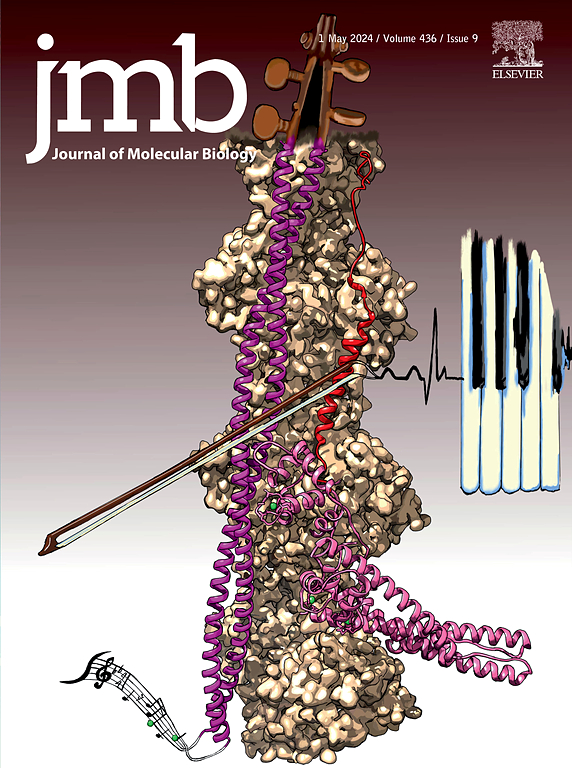High-resolution Sequencing Reveals that the Paf1 Complex May be a Conserved Transcription Elongation Factor for Eukaryotic RNA Polymerase I
IF 4.5
2区 生物学
Q1 BIOCHEMISTRY & MOLECULAR BIOLOGY
引用次数: 0
Abstract
In eukaryotes, at least three Pols (I, II, and III) are responsible for synthesizing unique RNA products. Many trans-acting factors affect the efficiency of transcription by the three Pols. Some of these factors influence more than one of the nuclear Pols. One such factor is polymerase-associated factor 1 complex (Paf1C). Paf1C, composed of five subunits in Saccharomyces cerevisiae (yeast), has been shown to promote transcription by Pols I and II and is conserved across eukaryotes. Although several studies have demonstrated that Paf1C associates with Pol I machinery, its roles in ribosomal RNA synthesis are not well-defined. In this study, we used native elongating transcript sequencing (NET-seq), to investigate the effect of the loss of two of the five Paf1C subunits (Paf1 and Cdc73) on Pol I occupancy at single-nucleotide resolution in yeast. We found that in both paf1Δ and cdc73Δ mutants, there was a significant reduction in Pol I occupancy at the 5′ end of the DNA template as compared to WT yeast, accompanied by other occupancy pattern changes throughout the gene. To complement these results, we also analyzed a PRO-seq dataset that was generated with DLD1 mammalian cells. Interestingly, we found that when Paf1C was knocked-down, there was also a reduction in the occupancy of Pol I at the 5′ end of the gene, consistent with our NET-seq analysis. Overall, our results support the conclusion that Paf1C is an important transcription elongation factor for Pol I and may play a conserved role across species.

高分辨率测序显示,Paf1复合体可能是真核RNA聚合酶I的保守转录延伸因子。
在真核生物中,至少有三个pol (I, II和III)负责合成独特的RNA产物。许多反式作用因子影响这三个极点的转录效率。其中一些因素影响着不止一个核大国。其中一个因素是聚合酶相关因子1复合体(Paf1C)。Paf1C在酵母中由5个亚基组成,已被证明可促进pol I和II的转录,并且在真核生物中是保守的。尽管一些研究表明Paf1C与Pol I机制相关,但其在核糖体RNA合成中的作用尚未明确。在这项研究中,我们使用天然延长转录序列(NET-seq)来研究酵母中Paf1C 5个亚基中的两个(Paf1和Cdc73)的缺失对单核苷酸分辨率下Pol I占用的影响。我们发现,在paf1Δ和cdc73Δ突变体中,与WT酵母相比,DNA模板5'端的Pol I占用率显著降低,并伴随着整个基因的其他占用模式变化。为了补充这些结果,我们还分析了用DLD1哺乳动物细胞生成的PRO-seq数据集。有趣的是,我们发现当Paf1C被敲除时,基因5'端Pol I的占用也减少,这与我们的NET-seq分析一致。总的来说,我们的研究结果支持Paf1C是Pol I重要的转录延伸因子,并且可能在物种间发挥保守作用的结论。
本文章由计算机程序翻译,如有差异,请以英文原文为准。
求助全文
约1分钟内获得全文
求助全文
来源期刊

Journal of Molecular Biology
生物-生化与分子生物学
CiteScore
11.30
自引率
1.80%
发文量
412
审稿时长
28 days
期刊介绍:
Journal of Molecular Biology (JMB) provides high quality, comprehensive and broad coverage in all areas of molecular biology. The journal publishes original scientific research papers that provide mechanistic and functional insights and report a significant advance to the field. The journal encourages the submission of multidisciplinary studies that use complementary experimental and computational approaches to address challenging biological questions.
Research areas include but are not limited to: Biomolecular interactions, signaling networks, systems biology; Cell cycle, cell growth, cell differentiation; Cell death, autophagy; Cell signaling and regulation; Chemical biology; Computational biology, in combination with experimental studies; DNA replication, repair, and recombination; Development, regenerative biology, mechanistic and functional studies of stem cells; Epigenetics, chromatin structure and function; Gene expression; Membrane processes, cell surface proteins and cell-cell interactions; Methodological advances, both experimental and theoretical, including databases; Microbiology, virology, and interactions with the host or environment; Microbiota mechanistic and functional studies; Nuclear organization; Post-translational modifications, proteomics; Processing and function of biologically important macromolecules and complexes; Molecular basis of disease; RNA processing, structure and functions of non-coding RNAs, transcription; Sorting, spatiotemporal organization, trafficking; Structural biology; Synthetic biology; Translation, protein folding, chaperones, protein degradation and quality control.
 求助内容:
求助内容: 应助结果提醒方式:
应助结果提醒方式:


